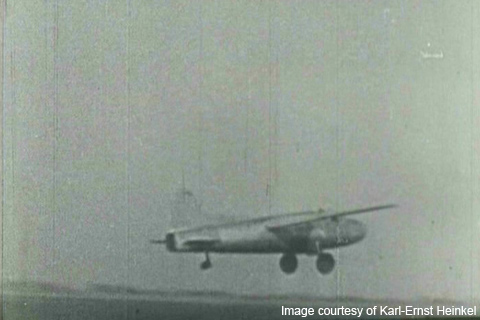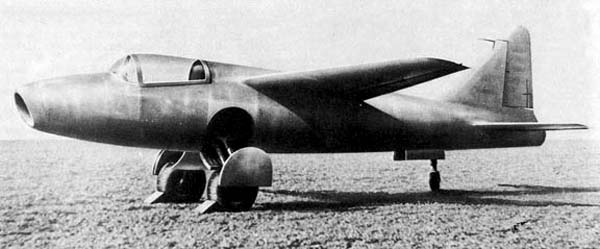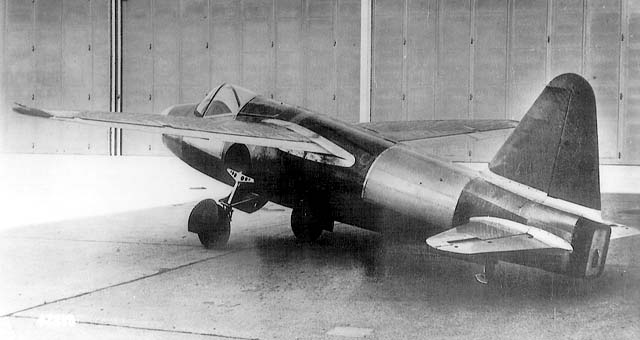Thursday 1 November 1939
Battle of the Atlantic: The British detain US freighter Exminster in Gibraltar.
Convoy OB 28 departs from Liverpool.
European Air Operations: The RAF makes reconnaissance flights over northwest Germany.
 |
| The He 178 in flight. |
Ernst Heinkel, however, is certain the technology will revolutionize aviation. He decides to proceed with his own private development of a jet fighter based on the He 178, the He 280, despite the RLM's disinterest. He does not know, though, that the RLM already is backing other jet projects, though their prototypes have not flown yet.
Poland: The Reich merges the portions of West Poland that had been ceded by the Treaty of Versailles into itself. This includes Danzig and the Polish Corridor. It creates within this territory new districts (Reichsgaue): Posen, Greater East Prussia, and Danzig West Prussia.
The Soviet Union similarly proceeds with its own annexation of eastern Poland into the Ukrainian Soviet Socialist Republic. While it has not Great War claims on its territory, it bases this decision on supposed "plebiscites" held in the territory which, naturally, supported the Soviet desires.
Holland: A "state of siege" is proclaimed along the border with Germany by Dutch Royal Decree. This means martial law.
Switzerland: The country prepares for a possible invasion, issuing decrees related to that eventuality.
British Government: Physicist Hans Ferdinand Mayer submits the Oslo Report on German weapons development.
Finland: The delegation returns to Moscow after Molotov's ultimatum of the day before.
Australia: Prime Minister Robert Menzies announces that the country will increase the size of the armed forces.
China: Chiang Kai-Shek launches a Winter Offensive in several places against the Japanese.
American homefront: The International Olympics Committee meets and decides that the 1940 Olympics cannot take place in Finland as planned. This effectively cancels the Games for 1940.
Holocaust: Mass killings of undesired inhabitants pursuant to Operation Tannenberg continues in Poland with liquidations in Bromberg (Bydgoszcz) by "Volksdeutscher Selbstschutz" and the Gestapo.
Future history: Barbara Bosson is born in Charleroi, Pennsylvania. She becomes famous in such 1960s films as "Bullitt" and 1980s television series as "Hill Street Blues."
October 1939
October 1, 1939: Occupation of WarsawOctober 2, 1939: Hel Peninsula Falls
October 3, 1939: The Diamantis Incident
October 4, 1939: Otto Kretschmer Gets Rolling
October 5, 1939: Polish Resistance Ends
October 6, 1939: Hitler Peace Effort
October 7, 1939: The British Have Arrived
October 8, 1939: First RAF Kill from UK
October 9, 1939: "City of Flint" Incident
October 10, 1939: Lithuania Under Pressure
October 11, 1939: The Atomic Age Begins
October 12, 1939: England Rejects Hitler's Peace Offer
October 13, 1939: Charles Lindbergh Speaks Out
October 14 1939: Royal Oak Sunk
October 15, 1939: Cuban Rockets
October 16, 1939: First Aircraft Shot Down Over UK
October 17, 1939: Marshall Mannerheim Returns
October 18, 1939: Prien Receives His Award
October 19, 1939: Preliminary Plan for Fall Gelb
October 20, 1939: Hitler Grapples with the Jews
October 21, 1939: Hurricanes to the Rescue!
October 22, 1939: Goebbels Lies Through His Teeth
October 23, 1939: Norway the Center of Attention
October 24, 1939: German "Justice" Gets Rolling
October 25, 1939: Handley Page Halifax Bomber First Flies
October 26, 1939: Jozef Tiso Takes Slovakia
October 27, 1939: King Leopold Stands Firm
October 28, 1939 - First Luftwaffe Raid on Great Britain
October 29, 1939: Tinkering with Fall Gelb
October 30, 1939: Defective Torpedoes
October 31, 1939: Molotov Issues an Ultimatum
November 1939
November 1, 1939: The Jet Flies AgainNovember 2, 1939: The Soviets Devour Poland
November 3, 1939: Amending the Neutrality Act
November 4, 1939: Roosevelt Signs Neutrality Laws
November 5, 1939: The Spirit of Zossen
November 6, 1939: First Dogfight
November 7, 1939: More Lies About SS Athenia
November 8, 1939: Hitler Almost Killed
November 9, 1939: The Venlo Incident
November 10, 1939: Dutch Panic
November 11, 1939: Poignant Armistice Day
November 12, 1939: Peace Efforts Made and Rejected
November 13, 1939: First Bombing of Great Britain
November 14, 1939: The Dyle Plan
November 15, 1939: Elser Confesses to the Bürgerbräukeller Bombing
November 16, 1939: Martial Law in Prague
November 17, 1939: International Students Day
November 18, 1939: Magnetic Mines
November 19, 1939: Walls Around the Warsaw Ghetto
November 20, 1939: First RN Submarine Victory
November 21, 1939: Salmon & Gluckstein on the Prowl
November 22, 1939: British Recover A Magnetic Mine
November 23, 1939: HMS Rawalpindi Sunk
November 24, 1939: Japanese Enter Nanning
November 25, 1939: The Olympics are a War Casualty
November 26, 1939: Soviets Stage an "Incident" at Mainila
November 27, 1939: German Marriage Becomes Perilous
November 28, 1939: Judenrats in Poland
November 29, 1939: The Soviets Prepare to Invade Finland
November 30, 1939: Winter War Begins
2019



